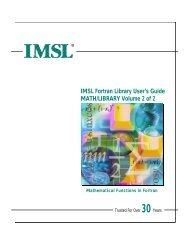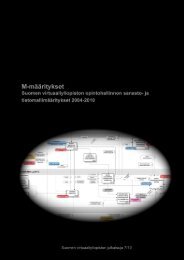ELMER, a computational tool for PDEs - Application to ... - CSC
ELMER, a computational tool for PDEs - Application to ... - CSC
ELMER, a computational tool for PDEs - Application to ... - CSC
You also want an ePaper? Increase the reach of your titles
YUMPU automatically turns print PDFs into web optimized ePapers that Google loves.
<strong>ELMER</strong>, a <strong>computational</strong> <strong><strong>to</strong>ol</strong> <strong>for</strong><br />
<strong>PDEs</strong> - <strong>Application</strong> <strong>to</strong><br />
vibroacoustics<br />
Juha Ruokolainen and Mikko Lyly<br />
<strong>CSC</strong> - Scientific Computing Ltd.<br />
<strong>ELMER</strong> is a software package <strong>for</strong> solving Partial Differential Equations (<strong>PDEs</strong>)<br />
by Finite Element Method (FEM). <strong>ELMER</strong> has been developed at <strong>CSC</strong> in<br />
collaboration with Technical Research Center of Finland (VTT), Helsinki<br />
University of Technology and University of Jyväskylä.<br />
In this article we present a case study of a new feature included in <strong>ELMER</strong>,<br />
vibroacoustics. Vibroacoustic problem consists of solving the natural vibration<br />
modes of elastic bodies, and the pressure waves generated by the vibration.<br />
Examples of vibrating elastic bodies are a guitar string or a tuning <strong>for</strong>k; you<br />
can propably come up with better examples yourself. The <strong>computational</strong><br />
domain <strong>for</strong> the pressure waves is usually the air surrounding the elastic body.<br />
Other solid bodies, if present, will scatter the pressure waves.<br />
We will go through an example step by step. We will first present the mathematical<br />
model, create the element mesh, define material parameters and<br />
boundary conditions and finally solve the system and visualize the results.<br />
The mathematical model <strong>for</strong> vibroacoustic problems<br />
¡<br />
£¥¤§¦<br />
¡ ¢<br />
¨<br />
The linearized dynamical equations <strong>for</strong> elastic bodies, without external <strong>for</strong>ces<br />
can be written as<br />
2u<br />
t 2<br />
(u) 0, (1)<br />
where u is the displacement vec<strong>to</strong>r and ¦<br />
is the stress tensor,<br />
¦ (u) ¨© ( £¥¤ u)I ( £ u ( £ u) T ). (2)<br />
1
2<br />
<br />
© Here and are the first and second Lamé parameters respectively. The<br />
Lamé parameters are directly related <strong>to</strong> the more commonly available material<br />
parameters elastic modulus E and Poisson ratio :<br />
©¨<br />
E<br />
, ¨<br />
¢<br />
2 (1 )(1 )<br />
E<br />
. (3)<br />
2(1 )<br />
Fourier trans<strong>for</strong>m of the elasticity equations with respect <strong>to</strong> time variable<br />
gives<br />
2<br />
U<br />
£¤¦<br />
(U) ¨ 0, (4)<br />
¢<br />
¢<br />
which, by standard finite element methodology, may be written in matrix<br />
<strong>for</strong>m as<br />
¨<br />
2<br />
KU MU, (5)<br />
where the K and M are the stiffness and mass matrices respectively. This<br />
equation may be considered as a generalized eigenvalue problem, giving the<br />
natural vibration modes of the elastic body.<br />
The wave equation<br />
1<br />
c2 2 ¡<br />
p<br />
¡<br />
t 2 ¨<br />
2 £<br />
p, (6)<br />
describes pressure waves in the air. The pressure and density variations and<br />
air speed are considered so small that dissipative effects and convective transport<br />
of momentum may be neglegted. The parameter c is the speed of sound.<br />
The Fourier trans<strong>for</strong>m of the wave equation is called the Helmholtz equation:<br />
£ 2 P ¨ 0, (7)<br />
¢ k2 ¢<br />
P<br />
where the wave number k is given by ¨<br />
<br />
k c. With a linear material law<br />
the whole equation is linear and no dispersion of harmonic components will<br />
occur. It is then possible <strong>to</strong> compute the response <strong>to</strong> any signal, <strong>for</strong> example<br />
the response <strong>to</strong> vibration of an elastic body, one Fourier component at a time.<br />
To complete the system we need boundary conditions. In our example the<br />
elastic body is a tuning <strong>for</strong>k fixed at the bot<strong>to</strong>m of the grip. For the Helmholtz<br />
equation we will need three kinds of boundary conditions. The first boundary<br />
condition is at the boundary between the vibrating body and the air, where<br />
we have <strong>to</strong> specify acceleration of the body:<br />
£ ¤<br />
¨<br />
2 ¤<br />
P n U n, (8)<br />
where is the density of air. The second boundary condition is at the boundary<br />
between the solid bodies and the air:<br />
£ P ¤ n ¨ 0, (9)
describing reflection of the pressure waves from solid walls. The last boundary<br />
condition we will use is the so called Sommerfeldt or far field boundary<br />
condition, which approximates the continuation of the physical domain from<br />
where we have <strong>to</strong> cut the <strong>computational</strong> mesh:<br />
In time domain this equation is<br />
£ P ¤ n ¨ ik P. (10)<br />
¡<br />
¤ 1<br />
£ p<br />
p ¡ n . (11)<br />
¨<br />
c t<br />
¢<br />
The sign of the time derivative term on the right represents incoming and<br />
outgoing waves respectively.<br />
Setting up the computation: mesh generation, material parameters and<br />
boundary conditions<br />
The <strong>ELMER</strong> package has a graphical interface called <strong>ELMER</strong> Front. This<br />
program is used as a <strong><strong>to</strong>ol</strong> <strong>to</strong> describe the <strong>computational</strong> problem. Defining<br />
the geometry, generating the <strong>computational</strong> mesh, selecting the equations <strong>to</strong><br />
be solved, setting the material parameters and boundary conditions may all<br />
be done through <strong>ELMER</strong> Front.<br />
<strong>ELMER</strong> Front has its own simple 2D geometry input <strong>for</strong>mat which will be<br />
used in this example. In addition, <strong>ELMER</strong> Front can read some of the most<br />
common geometry <strong>for</strong>mats exported by various CAD programs. Even predefined<br />
meshes may be imported <strong>to</strong> <strong>ELMER</strong> Front <strong>for</strong> boundary condition<br />
settings and conversion <strong>to</strong> <strong>ELMER</strong> Solver <strong>for</strong>mat.<br />
The geometry and the <strong>computational</strong> mesh of our example are shown in figure<br />
1. Figure 2 shows the <strong>ELMER</strong> Front panel where we define mesh parameters,<br />
such as mesh density and element types. For the elasticity equations<br />
it is always a good idea <strong>to</strong> use higher order elements than linear, and so we<br />
have selected quadratic elements.<br />
Figure 3 shows how <strong>to</strong> set boundary conditions, in this case the boundary<br />
conditions <strong>for</strong> fixing the bot<strong>to</strong>m of the vibrating tuning <strong>for</strong>k.<br />
The Solution of the equations<br />
<strong>ELMER</strong> Solver discretizes the equations by Finite Element Method, and<br />
solves the resulting linear or nonlinear systems, providing input <strong>for</strong> further<br />
analysis and visualization of the results. In addition <strong>to</strong> the equations used<br />
in this example, <strong>ELMER</strong> Solver may solve several other sets of equations:<br />
the Navier-S<strong>to</strong>kes equations in both compressible and incompressible <strong>for</strong>ms,<br />
magnetic induction equation, heat equation including diffuse gray radiation,<br />
3
4<br />
Figure 1: Mesh and geometry of the tuning <strong>for</strong>k and the air.<br />
Figure 2: Mesh parameter setting panel of <strong>ELMER</strong> Front.
Figure 3: Boundary condition setting panel of <strong>ELMER</strong> Front.<br />
and nonlinear elasticity and wave equations also in the time domain. A general<br />
advection-diffusion-reaction equation <strong>for</strong> scalar variables is also available.<br />
Any combination of these equations with various interdependencies<br />
may be solved at the same time. The solver is also easily extensible, so that<br />
user may define his/her own sets of equations.<br />
Here we will compute the second lowest natural vibration mode of the tuning<br />
<strong>for</strong>k, and use it as input <strong>for</strong> the Helmholtz equation solver.<br />
In this example, the linear equation system from the Helmholtz equation was<br />
solved by iterative solution method (BiCGStab) using incomplete LU fac<strong>to</strong>rization<br />
(ILU(T)) as a preconditioner.<br />
The generalized eigenvalue problem, <strong>for</strong> the structural vibration modes, was<br />
solved using the ARPACK package devoloped at the Department of Computational<br />
and Applied Mathematics at Rice University, Texas.<br />
Visualizing the results<br />
<strong>ELMER</strong> Solver output is a large text file of tabularized numbers. In this case<br />
the numbers are the vibration amplitudes of material points of the tuning <strong>for</strong>k,<br />
and coefficients of the Fourier components of pressure <strong>for</strong> each of the natural<br />
frequencies.<br />
<strong>ELMER</strong> Post may be used <strong>to</strong> display the results in a more understandable<br />
<strong>for</strong>m. <strong>ELMER</strong> Post can display, <strong>for</strong> example, the de<strong>for</strong>med geometry of the<br />
5
6<br />
Figure 4: The vibration mode shape of the tuning <strong>for</strong>k.<br />
Figure 5: Energy density of the pressure field.<br />
elastic body. It may also be used <strong>to</strong> compute the time variation of the pressure<br />
field,<br />
¨ P(t) Re(P)cos( <br />
t) Im(P)sin( <br />
t), (12)<br />
and display the time evolution as an animation. The vibration of the elastic<br />
body may be displayed in the same manner.<br />
Figure 4 shows the vibration mode shape of the tuning <strong>for</strong>k. Figure 5 is the<br />
energy density contained in the pressure field at this particular frequency.<br />
Figure 6 shows the pressure field at one instance.<br />
Additional in<strong>for</strong>mation<br />
The <strong>ELMER</strong> package is available from <strong>CSC</strong>; <strong>for</strong> more in<strong>for</strong>mation contact
Figure 6: The pressure field.<br />
the authors. For academic use the package is provided without charge.<br />
Also check out our web pages from:<br />
http://www.csc.fi/elmer/<br />
In<strong>for</strong>mation about ARPACK is available from<br />
http://www.caam.rice.edu/software/ARPACK<br />
7









